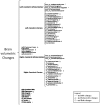Magnetic resonance imaging and neuropsychological testing in the spectrum of normal aging
- PMID: 24141834
- PMCID: PMC3782730
- DOI: 10.6061/clinics/2013(09)04
Magnetic resonance imaging and neuropsychological testing in the spectrum of normal aging
Abstract
Objective: To understand the relationships between brain structures and function (behavior and cognition) in healthy aging.
Method: The study group was composed of 56 healthy elderly subjects who underwent neuropsychological assessment and quantitative magnetic resonance imaging. Cluster analysis classified the cohort into two groups, one (cluster 1) in which the magnetic resonance imaging metrics were more preserved (mean age: 66.4 years) and another (cluster 2) with less preserved markers of healthy brain tissue (mean age: 75.4 years).
Results: The subjects in cluster 2 (older group) had worse indices of interference in the Stroop test compared with the subjects in cluster 1 (younger group). Therefore, a simple test such as the Stroop test could differentiate groups of younger and older subjects based on magnetic resonance imaging metrics.
Conclusion: These results are in agreement with the inhibitory control hypotheses regarding cognitive aging and may also be important in the interpretation of studies with other clinical groups, such as patients with dementia and mild cognitive impairment.
Conflict of interest statement
No potential conflict of interest was reported.
Figures
Similar articles
-
Relationship between regional brain volumes and cognitive performance in the healthy aging: an MRI study using voxel-based morphometry.J Alzheimers Dis. 2012;31(1):45-58. doi: 10.3233/JAD-2012-111124. J Alzheimers Dis. 2012. PMID: 22504316
-
COBRA: A prospective multimodal imaging study of dopamine, brain structure and function, and cognition.Brain Res. 2015 Jul 1;1612:83-103. doi: 10.1016/j.brainres.2014.09.010. Epub 2014 Sep 17. Brain Res. 2015. PMID: 25239478
-
Sex differences in human brain morphometry and metabolism: an in vivo quantitative magnetic resonance imaging and positron emission tomography study on the effect of aging.Arch Gen Psychiatry. 1996 Jul;53(7):585-94. doi: 10.1001/archpsyc.1996.01830070031007. Arch Gen Psychiatry. 1996. PMID: 8660125
-
Cognitive reserve.Neuropsychologia. 2009 Aug;47(10):2015-28. doi: 10.1016/j.neuropsychologia.2009.03.004. Epub 2009 Mar 13. Neuropsychologia. 2009. PMID: 19467352 Free PMC article. Review.
-
Association between prefrontal activity and volume change in prefrontal and medial temporal lobes in aging and dementia: a review.Ageing Res Rev. 2013 Mar;12(2):479-89. doi: 10.1016/j.arr.2012.11.001. Epub 2012 Nov 24. Ageing Res Rev. 2013. PMID: 23183352 Review.
Cited by
-
Neuroimaging Research on Dementia in Brazil in the Last Decade: Scientometric Analysis, Challenges, and Peculiarities.Front Neurol. 2021 Mar 15;12:640525. doi: 10.3389/fneur.2021.640525. eCollection 2021. Front Neurol. 2021. PMID: 33790850 Free PMC article. Review.
-
Longitudinal assessment of magnetization transfer ratio, brain volume, and cognitive functions in diffuse axonal injury.Brain Behav. 2022 Mar;12(3):e2490. doi: 10.1002/brb3.2490. Epub 2022 Feb 1. Brain Behav. 2022. PMID: 35103410 Free PMC article.
References
-
- Drag LL, Bieliauskas LA. Contemporary review 2009: cognitive aging. J Geriatr Psychiatry Neurol. 2010;23(2):75–93. - PubMed
-
- Hou BL, Hu J. MRI and MRS of human brain tumors. Methods Mol Biol. 2009;520:297–314. - PubMed
-
- Brucki SM, Nitrini R, Caramelli P, Bertolucci PH, Okamoto IH. [Suggestions for utilization of the mini-mental state examination in Brazil] Arq Neuropsiquiatr. 2003;61(3B):777–81. - PubMed
MeSH terms
LinkOut - more resources
Full Text Sources
Other Literature Sources
Medical




